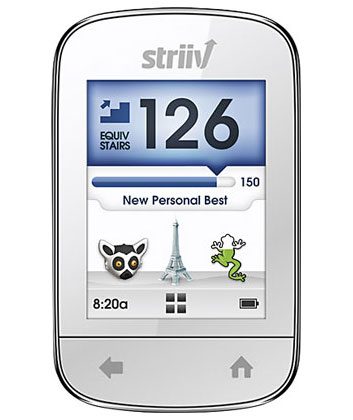
Integrate activity into daily life
What Canadians need is a new way of quantifying activity. To keep from getting bigger, we need to start thinking smaller. Instead of measuring our exercise efforts in minutes and kilometres, we need to break it down to individual steps.
Canadian non-profit organization ParticipACTION recommends taking at least 10,000 steps a day. Studies have found that’s the level at which you’re burning enough calories to reduce the risk of obesity and chronic disease.
Despite those convincing factors, the 10,000-step rule still has yet to be widely adopted. It could be because most people don’t wear pedometers, or because most of us have no clue what all those steps mean in everyday terms.
Here’s a baseline to consider: People living completely sedentary lives take about 2,000 steps a day; non-exercisers, on a typical day, take closer to 4,000 steps. Anything below 5,000 daily steps should be counted as sedentary.
Spend a couple of days wearing a pedometer and your perspective on exercise will change dramatically. It will make you more conscious of being active; your concept of exercise will evolve from something you do for a specific time at a certain place (in the morning at the gym, in the afternoon on the tennis court) to something you do all day, everywhere.
Experts now believe that a shift in focus from “working out” to “being active” is the key to getting fit and staying trim for life. In fact, researchers at the University of South Carolina estimate that women who are active 75 percent of the day (running errands, gardening, cooking and so on) expend about 10 percent more energy overall than those who visit the gym for an hour but are sedentary the rest of the day (usually because they’re sitting in front of a computer).
That’s right: A day of housework can trump an hour on the treadmill.

Spread it around
Here’s another way to look at it: Because we’re so busy, most of us feel we need to put exercise in a box. Walking is something we do for a half hour before work or after lunch. It’s kept separate from real life, as something that needs to be scheduled and worked around. Which means it will forever remain a chore or something easily bumped from our neverending to-do list.
To lose weight and keep it off for good, take exercise out of that box and spread it throughout your life. You can accomplish this by wiping the word “exercise” out of your vocabulary and replacing it with the word “activity.” And you can do it by focusing on individual steps.

Buy a pedometer
Here’s what you’re going to do: Head to your local sporting-goods store and buy a pedometer (they’re usually less than $20). Put it on first thing in the morning and check it before and after doing…well, anything. Before long, you’ll become a pretty good judge of how many steps you take doing your normal day-to-day activities.
Now start to think about how to increase the number of steps you take in an ordinary day. One rule of thumb is to raise your activity level about 10 to 20 percent a week.
If you’re emerging from a winter of hibernation, consider yourself sedentary (you might take about 3,000 daily steps), and add about 300 to 600 steps weekly. That’ll not only keep you from straining yourself, but motivate you psychologically by conveying a sense of progress.
Note that it doesn’t matter how long or short your strides are, or whether your daily steps are taken uphill or down, indoors or out. For simplicity’s sake, a step is a step is a step. Note, too, that allthe step counts in this section are estimates based on anecdotal rather than scientific evidence.

Aim for 10,000 steps a day
To start, put on your pedometer firstthing in the morning and don’t take it off until bed. Note the number of steps you take every day. At the end of the week, calculate your daily average.
Once you have a good sense of how many steps you’re taking (or not taking) every day, begin to look for easy ways to beef up your step numbers by 10 to 20 percent. Brainstorm how you can add more steps every day, when you’re running errands, working or tidying up.
Once you’ve succeeded in increasing your steps by 20 percent, calculate the number it would take to increase by another 20 percent. Work your way up gradually, and never feel that you have to exhaust yourself. You’ll soon find that 10,000 steps isn’t such a huge number, after all!
Click through for some ideas on how to reach your goal.

100 to 500 steps
Park in the furthest row at work, the supermarket or the mall.
After parking, take the scenic route. Use the mall or supermarket entrance farthest from your parking spot.
Never use the drive-through at any restaurant or bank. Park and walk inside to do your business.
Go out the back door instead of the front, and return the same way.
Take the stairs throughout the day, rather than the escalator or elevator.
Walk around the house for five minutes making a to-do list.
Use the farthest bathroom from where you are sitting.

500 to 1000 steps
Walk the kids to a different bus stop. There’s no rule that says you have to use the same one every morning.
Pace around while you talk on the phone, making it a rule to never sit down – even during a long call.
Cook and serve a homemade dinner to your family.
Get up and walk down the hall so you can chat face-to-face with your coworkers, instead of emailing or phoning them.
Spend 20 minutes tidying up around the house.
Stroll around the house during every Coronation Street commercial break.
Never use the moving walkways in airports – transport yourself.

1,000 to 2,500 steps
Walk anywhere that takes less than five minutes to reach by car.
Get up from your desk chair every 90 minutes during the course of an eight-hour day, and walk the full perimeter of your business or work area.
Go for a leisurely 20-minute walk after dinner.
Spend 15 minutes vacuuming up all the cat hair.
Do light housework for an hour.
Spend an hour gardening.
Wash and wax the car.
Do an hour of vigorous yoga.
Stay on your feet and mingle at a cocktail party, instead of spending the whole night hovering around the cheese plate.

2,500 to 5,000 steps
Go to the mall, forget where you parked your car and spend half an hour looking for it.
Take a leisurely 40-minute walk during your lunch hour.
Grocery-shop for one hour.
Go for a leisurely one-hour bike ride in a local park (pedal strokes count as steps, too).
Prepare food for, host and clean up after a dinner party.
Walk 30 minutes on a treadmill set at about 6 km/h.
Spend a few hours walking around a local museum.
Go bowling.

5,000 to 7,500 steps
Cut a large lawn with a push mower instead of a ride-on.
Spend an afternoon raking up all the leaves you didn’t deal with last fall.
Walk a 5k charity event.
Spend an afternoon walking around the downtown of a large city.
Dance the night away.

7,500 to 10,000 steps
Stroll back and forth to church (or temple, etc.) once a week.
Go golfing using a pull cart.
Volunteer at a hospital for 8 hours.
Take the dog for a brisk 60-minute walk in the park.
Get a part-time job as a waitress.

10,000 or more steps
Walk 10 km.
Spend the day shopping in downtown Toronto or Montreal.
Walk 90 minutes at a leisurely pace.
Babysit a four year old for 8 hours.
Related:
• 14 new ways to lose weight walking
• 4 ways to burn more calories when walking
• Our best healthy walking tips
